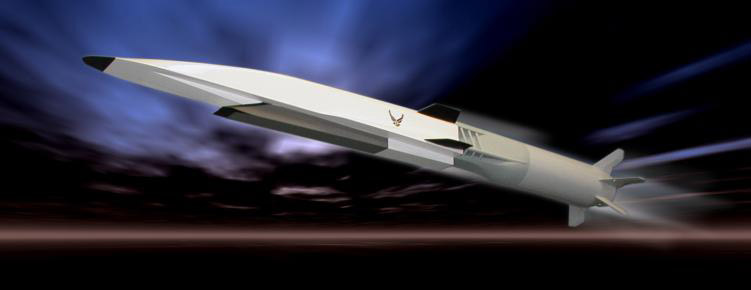Air Force to Test New Hypersonic Aircraft

WASHINGTON ? The U.S. Air Force is gearing up for the firstof four planned test flights of a hypersonic aircraft designed to operate formuch longer durations and cover far greater distances than previous platformsof its type.
The maiden flight of the X-51Waverider aircraft ? the first U.S. hypersonic vehicle to fly in six years? is scheduled to take place later in March. Boeing Defense, Space &Security Systems of St. Louis has been developing the aircraft since 2003 onbehalf of the Air Force Research Laboratory and Defense Advanced ResearchProjects Agency.
The missile-shaped X-51 will be carried aloft under the wingof a B-52 bomber, Joe Vogel, Boeing?s director of hypersonics, said in a Feb.22 interview. It will be released from the jet over the Pacific Ocean and dropfor four seconds until its rocket motor ignites and accelerates it to about5,800 kilometers per hour, just shy of the widely accepted start of hypersonicflight at Mach 5, or about 6,100 kilometers per hour. At that point, itsair-breathing scramjet ? or supersonic combustion ramjet ? engine, built byPratt & Whitney Rocketdyne of Canoga Park, Calif., will kick in, shootingthe craft to Mach 6, or more than 7,400 kilometers per hour.
Grand plans for hypersonic vehicles have been around fordecades, but their goals were often unrealistic and not matched by budgets,resulting in failure. The approach on X-51 has been to demonstrate thetechnologies that could one day enable things like single-stage-to-orbitvehicles.
?Theoretically you can probably get there someday, buttrying to do it all at once with not enough money is very, very challenging,?Vogel said.
Potential applications for hypersonic technology aresuperfast airplanes, missiles and reusable space launch vehicles, Vogel said.While the technology is not ready to ferry passengers from New York to LosAngeles in under an hour, such a scenario is not all that far-fetched, Vogelsaid. The upcoming demonstrations should show that the technology could be usedin a next-generation missile program, he said.
Boeing has 42 people working on the X-51program, down from a peak of about 90 people in 2007. Pratt & WhitneyRocketdyne?s team peaked around 60 people and is now down to nine people, Vogelsaid.
Get the Space.com Newsletter
Breaking space news, the latest updates on rocket launches, skywatching events and more!
Boeing also built the United States? previous hypersonicflight demonstrator, the X-43A, on behalf of NASA. The X-43A program madetwo successful flights in 2004: an 11-second flight that reached Mach 7, and a10-second flight that approached Mach 10 and set a new record for fastestflight by a jet-powered aircraft. Both vehicles were designed to plummet intothe ocean and be destroyed.
Scramjet engines like those on the X-43A and X-51 must beaccelerated to very high speeds to deliver compressed air to their combustionchambers. Both craft rely on rocket propulsion to create this initial speed.
While the X-51 will not reach the top speed of itspredecessor, it is intended to demonstrate more operationally realistictechnologies, Vogel said. Whereas the X-43A used a highly energetic hydrogenfuel, the X-51 uses the same JP-7 fuel that powered the SR-71 surveillanceaircraft, and its engine could be adapted to use other hydrocarbon-based fuels,he said. The X-51 is expected to fly about 900 kilometers under jet power inabout five minutes, 30 times longer in duration than the X-43A flights.
Boeing has built four X-51 aircraft for the upcoming testcampaign. Though none will be recovered after its test flight, theirliquid-cooled scramjet engines have shown in ground testing to be very durable,Vogel said. The X-43A engine was not actively cooled and was not intended forreuse.
?This [the X-51] engine has been tested extensively in thelaboratory, and it?s come out and been reused multiple times,? Vogel said. ?Intheory, if we had more time and more money and more space in the vehicle, weprobably would have put a recovery system into it. Future vehicles could have arecovery system, and we have started looking at ways to recover the engine.?
The government does not currently plan to support the X-51program beyond the four identical flight tests, which should be complete by thefall, Vogel said. Boeing has proposed a next phase of the program to thegovernment, but he declined to be specific.
Since 2003 the government has spent about $250 million onthe X-51 program, Vogel said. Air Force Research Laboratory spokesman DerekKaufman was unable to provide funding details by press time.
- Skydiver Plans Supersonic Jump from Edge of Space
- Image Gallery: X Planes
- New Video - From Science Fiction to Space Fact
Join our Space Forums to keep talking space on the latest missions, night sky and more! And if you have a news tip, correction or comment, let us know at: community@space.com.
Turner Brinton is the director for public relations at Maxar Technologies, a space technology company based in Westminster, Colorado that develops satellites, spacecraft and space infrastructure. From 2007 to 2011, Turner served as a defense reporter for SpaceNews International, a trade publication dedicated to the global space industry. He left SpaceNews in 2011 to work in communications for Intelsat and later DigitalGlobe before joining the Maxar team.











